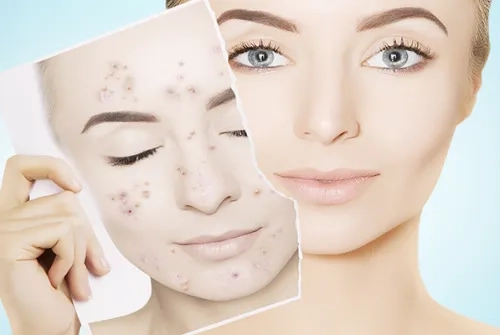Alo Yeditepe
Alo Yeditepe
Acne and Diet
What is Acne?
Acne vulgaris is a multifactorial and inflammatory skin disease affecting the pilosebaceous unit. Typical sites of involvement are the face, chest, and upper back. Characteristic lesions include comedones, papules, pustules, nodules, cysts, and scars. Although it affects all age groups, acne is primarily recognized as a disease of adolescence. However, in the last 10 years, it has been observed that the incidence in adults over the age of 25 has been increasing gradually. Although it is seen equally in men and women, it has a more severe course in men.
Why Does Acne Occur?
Many internal and external factors affecting the pilosebaceous unit play a role in the emergence of acne. Factors blamed for the emergence of acne vulgaris include abnormal follicular differentiation and increased ductal cornification, abnormal sebaceous gland activity, colonization of the pilosebaceous unit with microorganisms such as propionibacterium acnes, inflammation, hormones, neuropeptides, cytokines, antimicrobial peptides, toll-like receptors, diet, and stress.
Restricting Calorie Intake is Important
The connection between diet and acne has been controversial throughout history. From the 1930s to the 1960s, the diet was thought to trigger and play a major role in acne formation and patients were constantly informed about their dietary habits. The most important publication on the connection between diet and acne development was published in 2007 and the association between acne and products such as refined carbohydrates and skim milk was shown.
There is evidence that sebaceous gland production is related to diet. Dietary fat and carbohydrate intake have been shown to increase sebaceous gland production. The variety of carbohydrates may also alter sebum content. Restriction of caloric intake leads to a significant decrease in sebum production rate. Since the diet is a substrate provider for serum lipids, it can be hypothesized that dietary habits are part of the sebum production mechanism.
In a study comparing insulin-like growth factor-1 (IGF-1) levels and body mass index (BMI) with acne vulgaris severity, when normal skin was compared with skin with acne vulgaris lesions, IGF-1 levels were found to be increased in both the epidermis and pilosebaceous unit in lesioned skin. High IGF-1 concentration was associated with high BMI and severe acne vulgaris lesions.
A significant connection was found between daily dairy intake and acne lesions and exacerbation of acne lesions. IGF-1 is thought to have a role in the pathogenesis of acne vulgaris through its role in keratinocyte proliferation, fat lipogenesis, and androgen synthesis. A significant association between strong IGF-1, high BMI, and severe acne emphasizes the value of diet in the management of acne vulgaris.
What Foods Is Acne Most Associated With?
Foods that decrease FoxO1 levels in the nucleus by increasing the insulin/IGF signaling pathway but increase mTORC1 levels are the foods most responsible for acne. In studies, acne is mostly associated with the following 3 topics:
- Excessive sugar consumption (high glycemic index),
- Increased daily milk consumption,
- Increased consumption of trans fatty acids and saturated fats.
The diet of the Kitavan Island natives of Papua New Guinea and the ache hunter-gatherers of Paraguay consists of little processed plant and animal meat. It also lacks western carbohydrates. Acne lesions are absent in these societies with a low glycemic index diet. It is widely believed that high consumption of refined carbohydrates plays a key role in the pathogenesis of acne. The effect of high glycemic load diets on acne flare-ups has been confirmed by several placebo and case-control studies.
The glycemic index (GI) is a numerical system that measures the elevation of blood glucose triggered by carbohydrate intake. Glycemic load (GY) depends on carbohydrate content, glycemic index, and portion size. In short, a high GI/GY diet increases insulin and IGF-1 activity. It causes hyperinsulinemia that initiates the signaling cascade and a decrease in IGFBP-3 activity. Decreased IGFBP-3 leads to increased IGF-1 bioavailability.
IGF-1 stimulates the production of factors that play a key role in the pathogenesis of acne, such as sebocyte production, lipogenesis, and keratinocyte production. Insulin and IGF-1 together increase the synthesis of gonadal and adrenal androgens; sex hormone-binding globulin decreases hepatic synthesis and inhibits the function of androgen receptors. Causes increased activity of androgens and thus increased bioavailability. Androgens contribute to the pathogenesis of acne by increasing sebum production. Resveratrol is a flavonoid found in red grapes and wine and inhibits the growth of propionibacterium acnes by inhibiting its biofilm layer.
Some studies suggest that milk consumption may be a cause of acne lesions. Although milk has a low GI, it may worsen acne by increasing IGF-1 levels. This effect was seen especially with skim milk. This is because IGF in skim milk (but not in fat milk) causes keratinocyte proliferation and apoptosis. Milk also contains comedogenic hormones such as estrogen, progesterone, androgen precursors, and 5α-reductase. Another clinical condition showing the connection between acne and IGF is Laron syndrome. Laron syndrome is characterized by congenital IGF-1 deficiency. Acne formation was not observed in IGF-1 deficiency. All these results suggest that the presence of IGF-1 and androgens play a key role in acne formation.
The Relationship Between Acne and Smoking
Although the connection between smoking and acne is controversial, Schäfer et al. reported that the frequency of acne increased in smokers and a positive correlation was found between the amount smoked and severity.
The connection between smoking and acne is especially evident in post-adolescent acne, which is a clinic of acne seen during the post-adolescent period. In a study conducted by Capitanio et al. 73 percent of patients diagnosed with post-adolescent acne were found to be smokers. These results show the close connection between smoking and especially post-adolescent acne.
Consumption of high amounts of refined carbohydrates and products such as skimmed milk is associated with acne.
Assistant Professor Özlem AKIN
Yeditepe University Kozyatağı Hospital
Department of Skin and Venereal Diseases
About
Faculty and Year of Graduation:
Marmara University Medical Faculty, 1998
”
See Also
- What is Shingles? Shingles Symptoms and Treatment
- Does Sunburn Cause Skin Cancer?
- How Often Should You Take a Shower?
- Skin Rejuvenation With BBL Laser
- What Causes Skin Blemishes? How to Get Rid of Skin Blemishes?
- BBL Laser: What is Broadband Light Therapy?
- What is Fractional Carbondioxyde Laser?
- BBL Rosacea Treatment
- What is Golden Needle?, How is Golden Needle Treatment Done?
- What Is Rose Disease? Symptoms and Treatment of Rose Disease
- Sunburns Can Leave Permanent Damage
- Causes of Hair Loss
- Itching can be a Symptom of Another Disease
- Scabies Disease
- Ehlers-Danlos Syndrome
- Do Not Underestimate Itching!
- Intense Stress Makes Hair Ringworm
- Urticaria Decreases the Quality of Life
- 6 Ways to Protect Your Skin in Winter
- Pollen is Now Seen Outside of Seasonal Changes
- How Should We Protect Our Skin During the Summer Season?
- 15 Ways to Protect Skin During Winter
- Skin Microbiota May Affect Immunity!
- Sunburn
- How to Protect Yourself from Sunburn?
Alo Yeditepe






